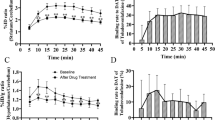Abstract.
Functional imaging of small animals, such as mice and rats, using ultra-high resolution positron emission tomography (PET) and single-photon emission tomography (SPET), is becoming a valuable tool for studying animal models of human disease. While several studies have shown the utility of PET imaging in small animals, few have used SPET in real research applications. In this study we aimed to demonstrate the feasibility of using ultra-high resolution SPET in quantitative studies of dopamine transporters (DAT) in the mouse brain. Four healthy ICR male mice were injected with (mean±SD) 704±154 MBq [99mTc]TRODAT-1, and scanned using an ultra-high resolution SPET system equipped with pinhole collimators (spatial resolution 0.83 mm at 3 cm radius of rotation). Each mouse had two studies, to provide an indication of test-retest reliability. Reference tissue kinetic modeling analysis of the time-activity data in the striatum and cerebellum was used to quantitate the availability of DAT. A simple equilibrium ratio of striatum to cerebellum provided another measure of DAT binding. The SPET imaging results were compared against ex vivo biodistribution data from the striatum and cerebellum. The mean distribution volume ratio (DVR) from the reference tissue kinetic model was 2.17±0.34, with a test-retest reliability of 2.63%±1.67%. The ratio technique gave similar results (DVR=2.03±0.38, test-retest reliability=6.64%±3.86%), and the ex vivo analysis gave DVR=2.32±0.20. Correlations between the kinetic model and the ratio technique (R 2=0.86, P<0.001) and the ex vivo data (R 2=0.92, P=0.04) were both excellent. This study demonstrated clearly that ultra-high resolution SPET of small animals is capable of accurate, repeatable, and quantitative measures of DAT binding, and should open up the possibility of further studies of cerebral binding sites in mice using pinhole SPET.
Similar content being viewed by others
Author information
Authors and Affiliations
Additional information
Electronic Publication
Rights and permissions
About this article
Cite this article
Acton, P.D., Choi, SR., Plössl, K. et al. Quantification of dopamine transporters in the mouse brain using ultra-high resolution single-photon emission tomography. Eur J Nucl Med 29, 691–698 (2002). https://doi.org/10.1007/s00259-002-0776-7
Published:
Issue Date:
DOI: https://doi.org/10.1007/s00259-002-0776-7



